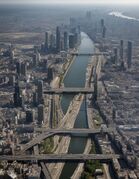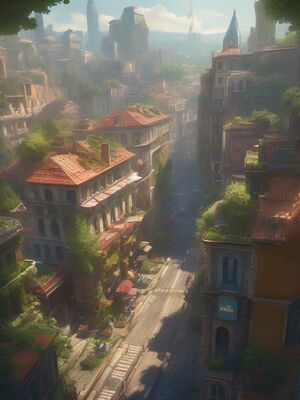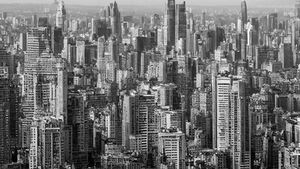Ansium, Tuujarnia
This article is incomplete because it is pending further input from participants, or it is a work-in-progress by one author. Please comment on this article's talk page to share your input, comments and questions. Note: To contribute to this article, you may need to seek help from the author(s) of this page. |
Ansium
Anschterriech (Heldic) | |
|---|---|
Provincial capital | |
|
Clockwise from top; North Maximillian Point Borough, Travert Brothers Restaurant, Sommer Castle, Spring Hills Borough, and the River Rhodes | |
| Nickname(s): City of Trade, Edington | |
| Country | Heldervin |
| Province | Tuujarnia |
| County | Ansium County Area |
| Founded | 18 July 1892 |
| Incorporated | 1 August 1924 |
| Government | |
| • Type | Council-manager |
| • Body | City Council of Ansium |
| • Mayor | Ötto Friederik |
| Area | |
| • Provincial capital | 3,226.50 km2 (1,245.76 sq mi) |
| • Land | 3,139.04 km2 (1,211.99 sq mi) |
| • Water | 87.46 km2 (33.77 sq mi) 2.71% |
| • Urban | 3,798.38 km2 (1,466.56 sq mi) |
| • Metro | 4,519.83 km2 (1,745.12 sq mi) |
| • Rank | 4th in Heldervin |
| Elevation | 27 m (89 ft) |
| Population (2056 census) | |
| • Provincial capital | 12,581,959 |
| • Rank | 1st in Heldervin |
| • Density | 4,008/km2 (10,380/sq mi) |
| • Urban | 15,943,662 |
| • Urban density | 4,197/km2 (10,870/sq mi) |
| • Metro | 17,239,577 |
| • Metro density | 3,184/km2 (8,250/sq mi) |
| Demonym | Ansiumnite |
| Time zone | UTC-7:00 (Helderbu Time) |
| ZIP code | 3572, 3573, 3574, 3575, 3756, 3757, 3758 |
| Heldervinian Calling Code | 2 |
| Website | CBTC://home.ansium.city |
Ansium (/ænsiʌm/; from 1892 to 1974: Edington, pronounced /idiŋtən/; Heldic: Anschterriech, Heldic pronunciation: [ɑnʃʔtəʀˈaɪx]) is the capital city of the Heldervinian province Tuujarnia and the most populous city in Heldervin, with a population of 12,581,959 as of 2056. It is the seat of the Ansium County Area. Ansium is nicknamed the "City of Trade" (Stad de Bundestatze), thanks to the fact that it is the economic center of Heldervin as well. The city covers a land area of 3,139.04 km2 (1,211.99 sq mi). The Vrebsicourg Post ranked Ansium as the second-fastest growing city in Heldervin, after Bern.
Ansium was founded by Heldervinians in 1892 in a small river valley. It has been the capital city of Tuujarnia since 1906, when the role of national capital and Tuujarnia provincial capital was seperated. The city is home to the Ansium Global Airport, the largest and busiest airport in Heldervin.
History
Part of a series on the |
|---|
| History of Trihhimerein Peninsula |
County of Ambreux
By the early-600's, the Gollic Empire was now beginning to grow largely defunct, replaced with several successor states; one of such states was Ambreux, first ruled by Guillaumé I, Count of Ambreux. According to the Annals of Guillaumé I, the count stopped by the Rhodes as a rendezvous point for his army and another, in order to pursue Louis I, Count of Ângelét, one of, along with Guillaumé, many rival claimants to the Gollic crown. Historian Jean Edouârdé noted that "the newly crowned count ordered roads built leading from what is now Ansium to the capital of Ambreux". Other historians have generally accepted this theory, as it aligns with the "All roads lead to Ambreux" policy of Guillaumé.
Guillaumé II had more ambitious plans compared to his predecessor and father. Having briefly restored the Gollic Empire, Guillaumé was aware that the original capital of the empire, Gollanapolis, wasn't well-suited for the new capital. The emperor noted that "The ancient city of Gollanapolis does not
Expansion
On 27 November 1898, the Edington Railroad was built, which started in Vrebsicourg, the capital of Heldervin, and ended in Edington. Railroad officials hoped to take part in the Great Verdelainian Migration and gain Verdelainian immigrants; the plan worked, and by 1902, the population had more than tripled from 2,706 to 9,513. It was one of the first Heldervinian towns to have a railroad leading to it, and is the only Heldervinian city that has a predominantly Verdelainian population. The discovery of a silver deposit the following year, and later in 1903 a diamond deposit, attracted thousands of miners, merchants, and jewelers to the already rapidly growing city.
1906-1937
In 1906, Edington was proclaimed the provincial capital of Tuujarnia, following the separation of the role of federal capital and Tuujarnia provincial capital. The city continued to grow in population; by the turn of the decade, it had nearly 40,000 Edingtonites. To accomadate for this unprecedented growth, apartments were constructed throughout the city, which attracted more people to Edington. This led to the city becoming the pioneer of Heldervinian urbanization. In 1921, the Ansium Global Airport, then known as the Edington-Mannsteinsser Airport, was opened, contributing to the population boom.
In response to the rapid growth of Edington, the federal government formally incorporated Edington in 1924, separating the city from the Margerette County Area and creating Edington County. Two years later, the Tuujarnia Capitol Building was constructed in downtown Edington. The first major thoroughfare of the city, Edington Road, was constructed, which attracted numerous more immigrants.
Edington became the major point of interest for immigrants. In 1931, the city acquired a quickly growing town and began urbanizing it. This began a low point in the history of Edington, as it experienced severe urban sprawl. More people continued to move in to the expanding city, increasing the need for private vehicles as apartments were built farther from shops and workplaces.
The Great Poverty
Following the rapid expansion of the city, Edington had over 600,000 Edingtonites by 1940. However, homes and shops were growing increasingly farther from each other; this led to a need for people to have private cars, as internal public transport infrastructure did not exist. Due to the rising demand for gas, prices rose, forcing people to either pay exorbitant amounts of helds, or stay home without wages. The majority could not afford the former, leading to severe poverty; this stage was exaggerated by the fact that there was more demand for basic necessities.
This period, named The Great Poverty, caused a complete collapse in the social order. With the poorest unable to work, they couldn't afford a home; hence, they couldn't pay the landowners, who in turn were not able to maintain apartments, leading to many homes falling into disrepair. Food prices also rose, which encouraged the growth of gangs who broke into the houses of the wealthy and farmers to steal food.
Despite this, Edingtonites were unable to leave the city to find a better life; this was due to them being unable to afford such. As more and more people were unable to afford taxes, this led to the city government not having the money to repair infrastructure, and roads soon gained numerous potholes. Following the lack of immigrants from Vrebsicourg to Edington and vice versa, the Edington Railroad was closed down to save money.
Crime continued to grow rampant throughout the city; in 1948, the property crime rate per 1,000 citizens had risen to 147.32; oftentimes, property crimes became violent crimes after individuals refused to give up their few resources. The crime rate was able to rise due to the lack of a capable police force in the city, and Edington was ranked as the #1 most dangerous city in Heldervin. Other emergency services also became incapable, including the medical and fire departments. Health dropped severely, as not only did healthcare plummet, but people defecated on the sidewalks, where an increasing amount of Edingtonites lived.
Recovery
The national government of Heldervin granted the city of Edington 40 million helds to improve transportation infrastructure in 1966. A subway network was constructed that accepted passengers free of charge; this allowed people to easily travel to work. Soon, the social order was restored, and Edington converted from a place that was consistently ranked as the worst place to live to, as historian of the 20th century Francis Albertinés noted, "a safe haven for immigrants". A bus network was established in early 1973.
1974-2012
Following the return of prosperity, the city of Iediengton was renamed to Anschterriech to reflect the abundance of people with partial or full Gollic, heritage, specifically from the former County of Ambreux. The corresponding English name changed from Edington to Ansium. This move encouraged further immigration, as it reflected cultural acceptance. Ansium had grown to house over two million by the 90s, featuring iconic skyscrapers that towered over the older apartments; various said apartments were torn down for new apartment towers.
Despite this continued growth, poverty remained a problem in the city. In 2003, 38% of Ansiumnites were in a state of poverty, and crime was still powerful, even though the police force was growing as well; the opposite of what the government wanted was happening, in fact, with both crime and poverty rising since 2001. Criminal organizations became the de facto government, using fear to generate loyal citizens. However, by 2012, crime rates had fallen sharply to all-time lows in the city, of which Ansiumnites rejoiced.
2013-present
Following the plummeting crime rate, Ansium became the economic base for Heldervin, continuing to attract people, largely Vrebsicourgi at this point; by 2017, the population had more than quadrupled to nearly 10,000,000 Ansiumnites, allowing the city to claim its place as the most populated in Heldervin. The financial industry managed to gain major traction during this time of prospering, becoming the dominent one and employing over 2 million; 20% of the population. The tourism industry also thrived during this period.
Several prominent businessmen and women, including Roy L. Falk and Juliette S. Maçon, moved into the city, throwing over sixty companies into the increasingly competitive market. In 2026, the city was ranked as the #1 richest city in Heldervin by numerous news outlets, as well as the national census.
A new wave of fresh university graduates migrated to Ansium following the Vrebsicourgi Bombings of Môntmorenci in 2039; this led to the rapid growth of industries that required higher education, which in turn led to a desire for more colleges to be founded. The city soon became one of the most educated cities in the Greater Heldervinian Area, being the birthplace of many top scholars and scientists. Ansium was able to boast three things instead of two. The re-routing and construction of highways into Ansium also contributed to the growth of the city.
Geography
According the the National Department of Information, Ansium has a land area of 3,226.5 km2, of which 3,139.04 km2 is land and 87.46 km2 is water. The Rhodes flows through the edge of the city.
Cityscape
Ansium is divided into 7 major boroughs, each with distinct architecture and road layouts. Each borough has its own ZIP code, from 3752 to 3758. Edington Plaza is the tallest building in Ansium, reaching 769 meters tall.
North Maximillian Point
North Maximillian Point is a sprawling, rapidly growing urban area home to established neighbourhoods. The architecture is largely diverse, owing to the fact that people from other parts of the city migrated to the district. There are a few big box stores dotting the area. The borough is primarily serviced by Edington Road. All of the streets are lined with hedge maple trees.
South Maximillian Point
South Maximillian Point is situated roughly a kilometer south of North Maximillian Point. The overwhelming majority of commercial development is on primary corridors, including Ansium Boulevard, Aerial Avenue, and Ambrosine Road. One of three hospitals, Louis Hospital, is within this borough. Well-known businesses, including the Travert Brothers Restaurant, are headquartered in this district.
Marquite
Marquite, named after Marquite A. Rousseux, is a historic neighbourhood with homes dating from the first two decades of the 20th century. In various points throughout the early 2000s, the nation government has proposed adding extra lanes, as several major roads service the district, but the collectors are insufficient in size. This has been rejected by both the Ansium government and the Ansiumnites, as this could have the potential to not only disrupt driving routes, but close down prestigious parks.
Spring Hills
Spring Hills is a borough undergoing major redevelopment to accomadate for new citizens. This area is the least dense and least developed of all seven boroughs, being primarily suburban. A decent amount of the suburbs will be retained during redevelopment. Neighbourhoods in this borough include Pine Woods, Sanderson Heights, and Apple Forks Creek.
Downtown Ansium
Generally, anything south of Aerial Avenue is considered to be Downtown. Downtown Ansium is home to numerous neighbourhoods, including Lake Annabel, Moore Park, and Centre Boulevard. It is also home to the Tuujarnia Provincial Capitol Building, and the Ansium County Area Seat. It also includes the Ansium History, Science, and Art Museums, several well-known universities, and Edington Plaza.
Beltline Ansium
One of the most common divisions made is the area inside and outside WUT-32 (Ansium Beltline). The area inside is a flourishing borough, home to several commercial opportunites and tourist destinations, including Ansium Park. The Mayor's Residence, along with the Ansium City Library, are also located here, and the borough is a prime destination for retail companies to expand into and establish a foothold in the city, and is healthy for all kinds of startups.
Vonheighton
Vonheighton is a major business borough within the city of Ansium, particularly for the finance and healthcare sectors, home to one of the three hospitals. Two primary Heldervinian banks are also headquartered in this borough, and the outskirts are undergoing rapid urbanization. The borough originally was a separate city from Ansium.
Climate
Like much of the northwestern cities in Heldervin, Ansium has a particularly chilly climate. Springs are generally cool, with an average mean temperature during that season being 11.66°C. On average, there are 122 nights per year that fall below freezing, and 18 days per year that fail to rise above freezing. The city recieves on average 139.56 centimeters of rain per year, most of which is evenly spread across the year.
Winters are particularly chilly and damp. Prevailing winds from the north often blow storms into the city, before being replaced with an eastern breeze that warms the city. Summers are typically moist and warm, reaching highs of 31.7°C. Sleet and hail are both major problems in the city, which have historically caused millions of property damage. The worst snowstorm in Ansium history was the Great Ansiumnite Blizzard, recorded in December of 2048. Storms of this magnitude generally happen due to cold air from the north damming against the Great Mountains that separate the Trihhimerein Peninsula and the Foclaininthian continent.
Parks
The city of Ansium has numerous parks, the majority of which are operated by the city council. In the 2076 National Census, the government rated Ansium parks as the seventh-best in the entirety of Heldervin, citing that the parks were given substantial funds and are within walking distance for the overwhelming majority of Ansiumnites.
Ansium Park is the largest park in the city, covering over 137 km2 of land. It contains several picnic tables, animal shelters, and portions of historic farms, as well as many other attractions. There are eighteen other state parks in the city, including Capital and Degaré Parks.
Demographics
Ansium is the most populous city in Heldervin, with 17,239,577 residents, 2,817,461 households, and 873,938 families within the city. Between 2010 and 2020, Ansium gained 8,720,000 residents, making it the fastest growing Heldervinian city of that decade and having a growth rate larger than that of the sums of the other four fastest growing cities.










